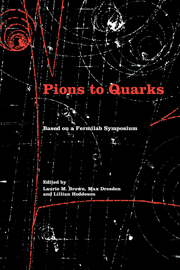Book contents
- Frontmatter
- Contents
- List of contributors
- Foreword by Leon M. Lederman
- Editors' acknowledgments
- Photographs of the symposium
- List of abbreviations
- List of notation
- I Introduction
- II Particle discoveries in cosmic rays
- III High-energy nuclear physics
- IV The new laboratory
- V The strange particles
- VI Weak interactions
- 24 Detection of the neutrino
- 25 Recollections on the establishment of the weak-interaction notion
- 26 Symmetry and conservation laws in particle physics in the fifties
- 27 A connection between the strong and weak interactions
- 28 The weak interactions from 1950 to 1960: a quantitative bibliometric study of the formation of a field
- VII Weak interactions and parity nonconservation
- VIII The particle physics community
- IX Theories of hadrons
- X Personal overviews
- Name index
- Subject index
25 - Recollections on the establishment of the weak-interaction notion
Published online by Cambridge University Press: 07 May 2010
- Frontmatter
- Contents
- List of contributors
- Foreword by Leon M. Lederman
- Editors' acknowledgments
- Photographs of the symposium
- List of abbreviations
- List of notation
- I Introduction
- II Particle discoveries in cosmic rays
- III High-energy nuclear physics
- IV The new laboratory
- V The strange particles
- VI Weak interactions
- 24 Detection of the neutrino
- 25 Recollections on the establishment of the weak-interaction notion
- 26 Symmetry and conservation laws in particle physics in the fifties
- 27 A connection between the strong and weak interactions
- 28 The weak interactions from 1950 to 1960: a quantitative bibliometric study of the formation of a field
- VII Weak interactions and parity nonconservation
- VIII The particle physics community
- IX Theories of hadrons
- X Personal overviews
- Name index
- Subject index
Summary
Introduction
I am very glad to have the opportunity to describe for this symposium some early, practically unknown, Dubna work on strange particles. It is quite natural that I would like people to be informed about some of my work, significant in my opinion, performed a long time ago, and the only way of fulfilling such a desire decently is to be invited to take part in a symposium. True, in his delightful talk on strange particles at the 1982 Paris colloquium on the history of particle physics, Murray Gell-Mann mentioned my work. I shall cover mainly Dubna work on new particles performed in 1951–5 in the context of the notion of weak interaction, a notion that was certainly not taken for granted in the early 1950s, but that had become one of my pet ideas as early as 1947.
Nuclear β decay, the first known weak process, was discovered by Ernest Rutherford about eighty-five years ago. However, not every physicist knows that the notion of weak interaction, a conception much wider than that of the single process of β decay, came to be well established only in the 1950s, that is, about fifty years after the discovery of β rays and about forty years after James Chadwick's discovery of the continuous β spectrum. Here I shall present personal recollections about the way the notion of weak interaction was born and then became well established. Of course, my story is going to be neither objective nor complete.
- Type
- Chapter
- Information
- Pions to QuarksParticle Physics in the 1950s, pp. 367 - 372Publisher: Cambridge University PressPrint publication year: 1989
- 2
- Cited by



